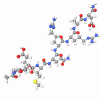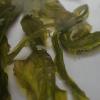It is thought that the Greeks first brought the rose from Greece to southern Italy. They believed the red rose came from the blood of the goddess Aphrodite, whose foot got stuck in a thorn while trying to help Adonis.
The flower's egg-shaped hips, or Rosa Canina's "false fruit," left after the flower has died, are a vibrant source of vitamin C, containing ten times the amount than in oranges.
Rosa Canina's hips also contain vitamins A, B2, E, K, and P and iron and copper compounds. Therefore, they were used as a tonic and general vitamin supplement in convalescence and for those generally debilitated.
Archaeological evidence shows that rosehips have been used in Britain for nearly 4,000 years, but it was only during World War II that they became recognized as an essential medicinal source of vitamin C. Rosehips also have astringent qualities and help treat bleeding gums, diarrhea, and leukorrhea.Rosa Canina Fruit Extract is a medium amber liquid with a characteristic odor. It has moisturizing and lenitive properties and is recommended for all skin and scalp cleansing products. It helps dry and chapped skin recover. Thanks to its nourishing, antioxidant, and astringent properties, it is used in many cleansers, moisturizers, creams, lotions, gels, and toners. It can also be used in hair care applications. The suggested dose level is 2 – 5 %.











